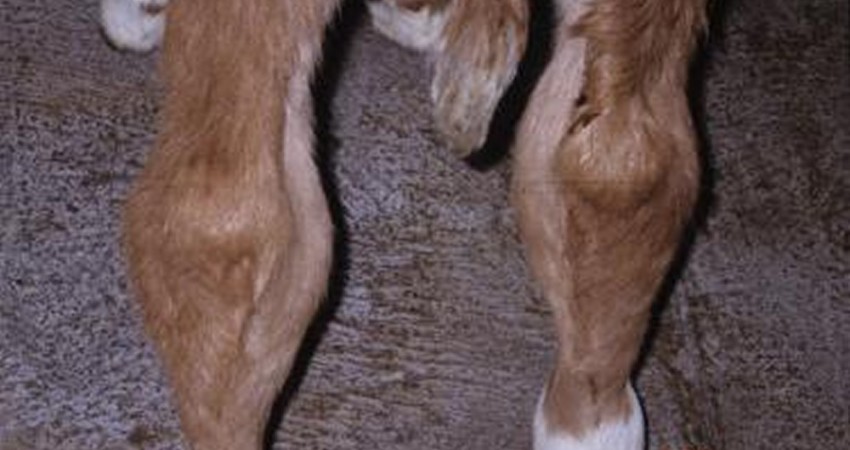

Arthritis means inflammation in one or more joints. In sheep, it is usually the result of bacterial infection. Arthritis usually causes lameness and visible swelling of at least two joints in the legs. Young lambs are most susceptible to arthritis infection. Mulesing and shearing lambs markedly increases the risk of arthritis.
Arthritis of sheep can resemble numerous other diseases that cause lameness, most importantly the exotic diseases foot and Mouth disease and Blue Tongue
Causes of arthritis
Bacteria enter the body through broken or wet, softened skin. In WA, Erysipelothrix rhusiopathiae bacteria are most commonly responsible for arthritis in sheep, causing the disease called erysipelas. E. rhusiopathiae bacteria can survive in soil, faeces and water for varying periods, but the main source of infection for lambs is probably their own mothers, who may carry the organism with no ill effect in the tonsils and pharynx.In addition to E. rhusiopathiae, other organisms occasionally cause arthritis, including the bacteria Histophilus ovis, Escherichia coli and some Streptococci and Staphylococci. Chlamydia psittaci — an organism which is neither a virus nor a bacterium — may also cause arthritis. It is not possible to identify the specific organism solely from the appearance of arthritic sheep.Lambs are most likely to become infected:at or soon after birth. Infection may enter via the umbilical cord, especially in wet pasture at marking (ear marking, tailing, castration)at mulesing when the lamb’s mother licks the wound (mulesing increases the risk of arthritis by seven times)at shearing via cuts (shearing lambs increases the risk of arthritis by four times)when held in yards after shearing or after mulesingat other times when the skin is broken or wet, for example, dog bites and dipping.
Signs of arthritis
Swelling of usually two or more limb joints, including the elbow, front knee (or carpus), stifle (the true knee, in the hind leg) and hock joints lameness, with reluctance to walk and increased time spent lying down. Usually more than one joint is affected, so sheep will often walk with a short-stepping, shuffling gait and hunched back weight loss because of pain, reduced appetite and reduced mobility.Although some sheep will recover spontaneously, a small proportion will remain chronically lame and in poor condition. These animals should be humanely destroyed.Always consult a veterinarian when sheep are lame as there are numerous causes of arthritis and of lameness in sheep including some exotic diseases such as foot-and-mouth disease.
Early diagnosis of an exotic disease will reduce its spread and limit the impact on your markets and your community.A veterinarian will provide the correct diagnosis and advise on the appropriate treatment. Early diagnosis and treatment can prevent deaths, and reduce losses due to condemnation of limbs or whole carcasses at slaughter.
Treatment
Once the cause of the arthritis is established, appropriate treatment can be given. A veterinarian may prescribe an effective antibiotic.If sheep are severely lame and emaciated, they are unlikely to recover. These animals should be humanely destroyed.If an outbreak of arthritis first occurs in recently mulesed lambs, it may be difficult to treat any immediately without causing further pain and distress to the lambs. Usually, many will recover spontaneously in 7–10 days without treatment, but it is important to assess the group frequently and initiate treatment as soon as possible, to minimise the number of chronically affected lambs.
Prevention
To prevent outbreaks of arthritis, if possible eliminate or minimise the predisposing conditions listed in the causes of arthritis section above.Not shearing or mulesing lambs will markedly reduce their risk of developing erysipelas arthritis. When marking or mulesing lambs, disinfect equipment as frequently as possible and do not do this work in wet or muddy conditions.If arthritis continues to be a significant problem despite taking all possible preventive measures, and a veterinarian has identified the condition as erysipelas arthritis, then consider introducing a vaccination program. A veterinarian will advise you on a vaccination program suited to your flock.
Erysipelas vaccine is not available in combination with other commonly used sheep vaccines. Ewes or lambs, or both, may be vaccinated, depending on whether erysipelas arthritis occurs following lamb marking (the most common time), or later, following shearing or subsequent shower or plunge dipping.Vaccinating ewes before lambing will protect their lambs, via colostrum, for the first eight weeks of life, covering the time of marking/mulesing.
Ewes need to be vaccinated twice initially with at least four weeks between doses, and then once every year. Give the second, or in subsequent years the single vaccination, to the ewe about four weeks before lambing starts.If arthritis usually occurs following the first shearing or subsequent plunge or shower dipping, vaccinate lambs. They will require two vaccinations, the first at about 4-6 weeks old and the second about four weeks later. Lambs born to unvaccinated mothers can be vaccinated for the first time at marking/mulesing but will not have protective immunity against erysipelas until after the second dose of vaccine is given.
 Contact Jaguza Support
Contact Jaguza Support